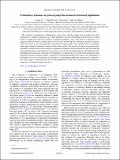Evolutionary dynamics of general group interactions in structured populations
Author(s)
Li, Aming; Broom, Mark; Du, Jinming; Wang, Long
DownloadPhysRevE.93.022407.pdf (609.4Kb)
PUBLISHER_POLICY
Publisher Policy
Article is made available in accordance with the publisher's policy and may be subject to US copyright law. Please refer to the publisher's site for terms of use.
Terms of use
Metadata
Show full item recordAbstract
The evolution of populations is influenced by many factors, and the simple classical models have been developed in a number of important ways. Both population structure and multiplayer interactions have been shown to significantly affect the evolution of important properties, such as the level of cooperation or of aggressive behavior. Here we combine these two key factors and develop the evolutionary dynamics of general group interactions in structured populations represented by regular graphs. The traditional linear and threshold public goods games are adopted as models to address the dynamics. We show that for linear group interactions, population structure can favor the evolution of cooperation compared to the well-mixed case, and we see that the more neighbors there are, the harder it is for cooperators to persist in structured populations. We further show that threshold group interactions could lead to the emergence of cooperation even in well-mixed populations. Here population structure sometimes inhibits cooperation for the threshold public goods game, where depending on the benefit to cost ratio, the outcomes are bistability or a monomorphic population of defectors or cooperators. Our results suggest, counterintuitively, that structured populations are not always beneficial for the evolution of cooperation for nonlinear group interactions.
Date issued
2016-02Department
Massachusetts Institute of Technology. Department of PhysicsJournal
Physical Review E
Publisher
American Physical Society
Citation
Li, Aming, Mark Broom, Jinming Du, and Long Wang. "Evolutionary dynamics of general group interactions in structured populations." Phys. Rev. E 93, 022407 (February 2016). © 2016 American Physical Society
Version: Final published version
ISSN
1539-3755
1550-2376